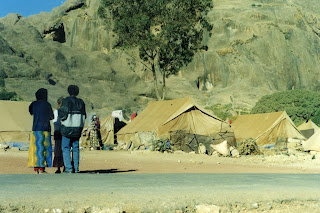The sands miscalled it
We (that is Neale
Venise and myself) had been trying to work out what had changed in
the Ténéré – an area of sandy plains located in northern-central
Sahara desert. It is within the shifting topography of this desolate
region that immense storms, manifesting as curtain walls of roiling
dust hundreds of feet high, lay down their foundations. Once they
grow beyond a certain critical mass they untether themselves and
advance approximately westwards at a walking pace, until they hit the
coast, at which point they deviate north or south, entering the
subtropical zones as windless monsoons that leave incongruous dunes
in their wake.
These storms are slow
to germinate, usually building to a peak over several months. Their
roots lie in the electrical charge that is generated by sand
particles moving against each other. These currents form meandering
v-shaped channels in the sand that can stretch for thousands of
miles. Typically when a gathering storm decamps it will remain close
to the ground and follow the electro-magnetic charge along the most
pronounced of these troughs. This makes it easy to determine the
pathway of a storm, and to either take avoiding action or temporarily
evacuate any affected settlements.
Predicting the course
of a storm used to entail placing sentries on high ground where they
could establish a pseudo bird's-eye view of the surrounding land. The
nomadic Sagembu were reputedly able to train ravens for this purpose.
These days, predictive measurements are taken by satellite.
Since 2019, more storms
have been observed deviating from their established courses and
lifting off into the heavens, only to descend from the otherwise
clear blue sky days later, like sudden ambushes, scattering tents and
tearing down mud brick buildings, before rising once more, leaving
behind an eerie stillness.
Neale and myself
witnessed a small storm detach from its expected pathway and rear off
at a slant, like a derailing locomotive. We believe that a storm's
separation from its electromagnetic root system causes it to become
susceptible to localised forces outside of those that generated it,
and thereafter wildly unpredictable.
Beyond that hypothesis,
we were never able to make any sense of it. Inconveniently, a few
hours after our arrival in Tahoua, I fell down the stairs at the
hotel and broke my right foot. There was no doctor available and I
was forced to rely on the ministrations of a local pharmacist. Of
course, Neale had to do all the driving, which was often difficult.
He had brought his
seven-year-old son, Graham's, fridge magnet collection with him to
“supercharge” along one of the storm lines. He put them down on
the ground for no more than a minute, while we took some
topographical readings. When he turned around to retrieve them, they
were gone, engulfed by the sands. We could never find them.
Graham is autistic and
was devastated by the loss of his magnets. It was the cause of an
enormous row between himself and his wife Fiona. I believe they even
separated for a while.
As if that wasn't
enough, Jack Sibson had returned to the Unified Wells & Aquifers
Company, following his exile in Germany. Predictably things went very
much as they had done before. Neale took Jack's side, which I think
he would agree in hindsight was a mistake. It put a distance between
the pair of us that neither of us was able to cross. Neale is retired
now and I wouldn't know how to contact him directly. For reasons I
will not go into, I have been on permanent sick leave since 2015.
Afterword
There is a eBook available, existing in the same world as what you have read above, and tenuously related to it:
The Missionary Dune - Sam Redlark




Comments
Post a Comment